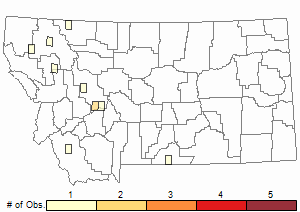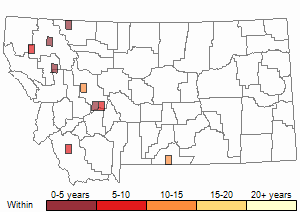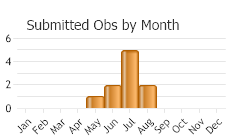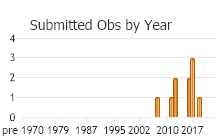Large Brown Moth With Spots on Bottom Wings One Eyed Sphinx Moth How Big as Baby, as Adult
View in other NatureServe Network Field Guides
NatureServe
Montana Utah Wyoming Idaho Wisconsin British Columbia
South Carolina Yukon
California New York
- Home - Other Field Guides
- Kingdom - Animals - Animalia
- Phylum - Insects, Springtails, Millipedes - Mandibulata
- Class - Insects - Insecta
- Order - Butterflies / Moths - Lepidoptera
- Family unit - Sphinx Moths - Sphingidae
- Species - One-eyed Sphinx - Smerinthus cerisyi
- Family unit - Sphinx Moths - Sphingidae
- Order - Butterflies / Moths - Lepidoptera
- Class - Insects - Insecta
- Phylum - Insects, Springtails, Millipedes - Mandibulata
- Kingdom - Animals - Animalia
1-eyed Sphinx - Smerinthus cerisyi
General Description
The 1-eyed Sphinx Moth (Smerinthus cerisyi) is a large (62 - 90 mm wingspan) heavy-bodied sphinx moth. The forewings are pale grey (occasionally tan) with a rather complex pattern of darker gray and black banding. The median and terminal areas in particular are dark. The outer margin of the forewing is scalloped, with a "tooth" at the anal angle. The hindwings are brilliant rose-pink, shading into tan toward the margin. There is a large black spot in the anal angle containing a vivid blue circumvolve, oft incomplete and sometimes with a second blue crescent above. The thorax is black, contrasting sharply with the wide pale grey tegulae (Anweiler and Robinson no date).
Phenology
The adults are nocturnal and come to lights. The larvae are solitary defoliators. In that location is one flying from May-August. The long flight period may bespeak that there is more than one generation per year in Alberta (Anweiler and Robinson no appointment).
Diagnostic Characteristics
The very similar Twin-spotted Sphinx Moth (S. jamaicensis) has two bluish bars instead of a blue circle in the hindwing spot, and the pink is sharply divided from the tan outer function of the hindwing. Pectinations on the male antennae are as well much shorter in cerisyi than in S. jamaicensis (Anweiler and Robinson no date).
Range Comments
The One-eyed Sphinx Moth ranges from Newfoundland and Maine due west across Michigan, the northern states, and southern Canada to British Columbia and Washington; and south to southern California, Baja California Norte and due west Texas. It also occurs in Tennessee and Missouri (Opler et al. 2010).
Observations in Montana Natural Heritage Program Database
Number of Observations: x
(Click on the following maps and charts to see full sized version) Map Aid and Descriptions
Relative Density

Recency



(Observations spanning multiple months or years are excluded from time charts)
Habitat
Valleys and streamsides (Opler et al. 2010).
Ecological Systems Associated with this Species
- Details on Creation and Suggested Uses and Limitations
How Associations Were Made
Nosotros associated the use and habitat quality (mutual or occasional) of each of the 82 ecological systems mapped in Montana for vertebrate animal species that regularly breed, overwinter, or migrate through the country by:- Using personal observations and reviewing literature that summarize the breeding, overwintering, or migratory habitat requirements of each species (Dobkin 1992, Hart et al. 1998, Hutto and Immature 1999, Maxell 2000, Foresman 2012, Adams 2003, and Werner et al. 2004);
- Evaluating structural characteristics and distribution of each ecological system relative to the species' range and habitat requirements;
- Examining the ascertainment records for each species in the state-broad point ascertainment database associated with each ecological system;
- Calculating the per centum of observations associated with each ecological system relative to the percent of Montana covered by each ecological system to get a mensurate of "observations versus availability of habitat".
Species that brood in Montana were just evaluated for breeding habitat use, species that only overwinter in Montana were but evaluated for overwintering habitat use, and species that only migrate through Montana were simply evaluated for migratory habitat utilise. In full general, species were listed equally associated with an ecological system if structural characteristics of used habitat documented in the literature were present in the ecological system or large numbers of point observations were associated with the ecological system. Even so, species were not listed every bit associated with an ecological system if at that place was no support in the literature for use of structural characteristics in an ecological system,
even ifpoint observations were associated with that system. Mutual versus occasional association with an ecological organisation was assigned based on the degree to which the structural characteristics of an ecological organisation matched the preferred structural habitat characteristics for each species as represented in scientific literature. The percentage of observations associated with each ecological organization relative to the percent of Montana covered by each ecological system was as well used to guide assignment of mutual versus occasional clan. If you have whatever questions or comments on species associations with ecological systems, please contact the Montana Natural Heritage Program's Senior Zoologist.
Suggested Uses and Limitations
Species associations with ecological systems should exist used to generate potential lists of species that may occupy broader landscapes for the purposes of landscape-level planning. These potential lists of species should not be used in identify of documented occurrences of species (this information tin can exist requested at: mtnhp.org/requests) or systematic surveys for species and evaluations of habitat at a local site level by trained biologists. Users of this information should be enlightened that the land cover data used to generate species associations is based on imagery from the belatedly 1990s and early 2000s and was but intended to be used at broader mural scales. Land cover mapping accuracy is particularly problematic when the systems occur equally small patches or where the country cover types have been contradistinct over the past decade. Thus, item caution should be used when using the associations in assessments of smaller areas (east.thousand., evaluations of public country survey sections). Finally, although a species may be associated with a detail ecological system within its known geographic range, portions of that ecological organization may occur exterior of the species' known geographic range.Literature Cited
- Adams, R.A. 2003. Bats of the Rocky Mountain West; natural history, ecology, and conservation. Boulder, CO: University Press of Colorado. 289 p.
- Dobkin, D. Due south. 1992. Neotropical migrant country birds in the Northern Rockies and Great Plains. USDA Woods Service, Northern Region. Publication No. R1-93-34. Missoula, MT.
- Foresman, M.R. 2012. Mammals of Montana. Second edition. Mount Printing Publishing, Missoula, Montana. 429 pp.
- Hart, M.Chiliad., Due west.A. Williams, P.C. Thornton, K.P. McLaughlin, C.M. Tobalske, B.A. Maxell, D.P. Hendricks, C.R. Peterson, and R.L. Redmond. 1998. Montana atlas of terrestrial vertebrates. Montana Cooperative Wildlife Research Unit, University of Montana, Missoula, MT. 1302 p.
- Hutto, R.L. and J.South. Young. 1999. Habitat relationships of landbirds in the Northern Region, USDA Forest Service, Rocky Mountain Research Station RMRS-GTR-32. 72 p.
- Maxell, B.A. 2000. Management of Montana'south amphibians: a review of factors that may present a risk to population viability and accounts on the identification, distribution, taxonomy, habitat use, natural history, and the status and conservation of individual species. Study to U.Due south. Woods Service Region 1. Missoula, MT: Wildlife Biology Program, University of Montana. 161 p.
- Werner, J.G., B.A. Maxell, P. Hendricks, and D. Flath. 2004. Amphibians and reptiles of Montana. Missoula, MT: Mountain Press Publishing Company. 262 p.
Food Habits
The larvae feed on willow (Salix) and poplar (Populus). The adults do not feed (Opler et al. 2010).
References
Source: https://fieldguide.mt.gov/speciesDetail.aspx?elcode=IILEX0F050
0 Response to "Large Brown Moth With Spots on Bottom Wings One Eyed Sphinx Moth How Big as Baby, as Adult"
Postar um comentário